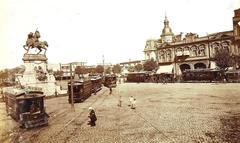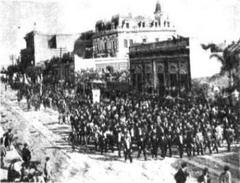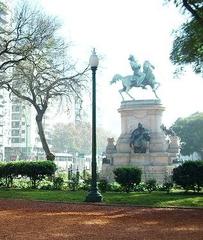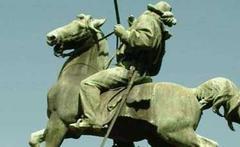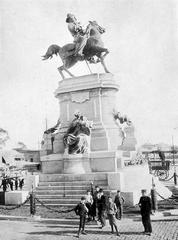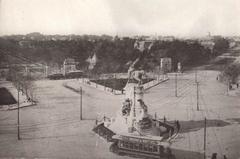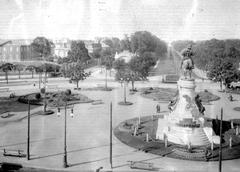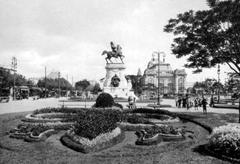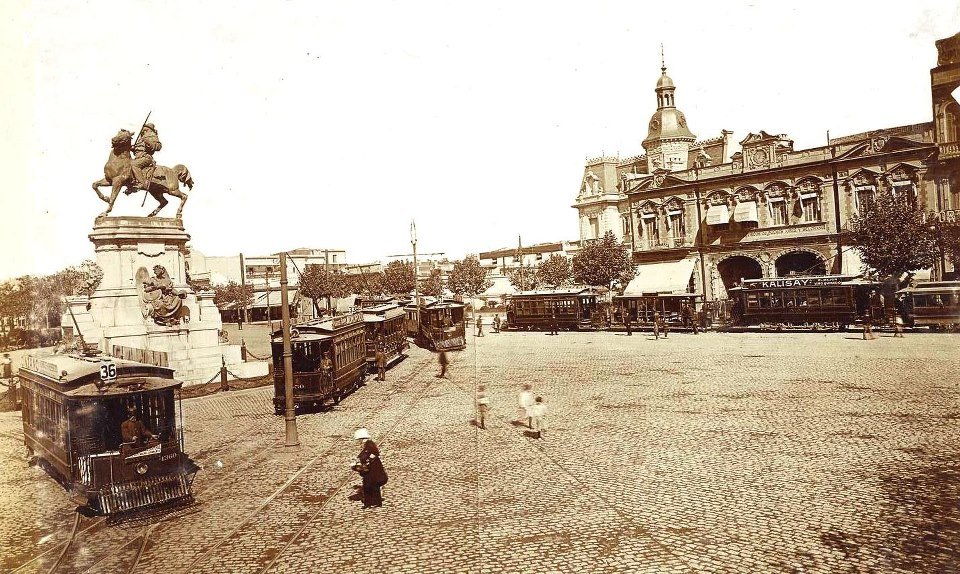
Visiting the Monument to Giuseppe Garibaldi in Buenos Aires: Hours, Tickets, and Travel Tips
Date: 14/06/2025
Introduction
The Monument to Giuseppe Garibaldi in Buenos Aires is a striking symbol of Italian-Argentine heritage, combining artistic grandeur, historical resonance, and cultural vitality. Located in the vibrant Palermo neighborhood at Plaza Italia, this imposing equestrian statue commemorates Giuseppe Garibaldi, the famed Italian general and unifier, and celebrates the enduring ties between Italy and Argentina. Erected in 1904 by the city’s Italian immigrant community, the monument serves as both a testament to Garibaldi’s revolutionary legacy and a focal point for community events, educational tours, and cultural celebrations (Buenos Aires Ciudad; ExpatPathways).
This guide offers a detailed overview for visitors, including historical context, artistic highlights, practical travel advice, accessibility information, and nearby attractions. Whether you are an art enthusiast, history buff, or casual traveler, the Monument to Giuseppe Garibaldi provides a unique window into Buenos Aires’ multicultural landscape and the stories that have shaped its identity.
Table of Contents
- Historical Context
- Artistic Design and Symbolism
- Political and Social Importance
- Location and Accessibility
- Visiting Hours and Tickets
- Travel Tips and Safety
- Nearby Attractions
- Special Events and Tours
- Visuals and Media
- Frequently Asked Questions (FAQs)
- Conclusion and Recommendations
- Sources
Historical Context
Italian Immigration and the Genesis of the Monument
By the early 20th century, Buenos Aires had become a hub for Italian immigrants, who made up a significant portion of the city’s population—estimated at nearly 40% by 1914 (buenosaires.gob.ar). The Monument to Giuseppe Garibaldi was conceived as a collective tribute from this community, honoring both their homeland and their new country. Through public fundraising and the efforts of Italian organizations, the statue was completed and unveiled on June 19, 1904, in a ceremony attended by President Julio Argentino Roca.
Garibaldi’s Role in Argentina
Giuseppe Garibaldi (1807–1882) is celebrated not only for his leadership in the unification of Italy but also for his adventures in South America. His involvement in the Uruguayan Civil War and campaigns across the Río de la Plata region (which includes parts of present-day Argentina and Uruguay) left a lasting impression on local history (buenosaires.gob.ar). Garibaldi’s revolutionary ideals and his efforts in defense of liberty resonated deeply with the Argentine-Italian community.
Artistic Design and Symbolism
The monument, crafted by Italian sculptor Eugenio Maccagnani, features Garibaldi in a dynamic equestrian pose atop a granite pedestal—his right arm raised, saber in hand, symbolizing leadership and the pursuit of liberty. The red granite base, sourced from Baveno, Italy, is adorned with bronze reliefs depicting historic episodes from Garibaldi’s life, such as the Battle of San Antonio and the Departure from Quarto (Buenos Aires Ciudad). Allegorical statues of Liberty and Victory flank the pedestal, reinforcing themes of emancipation and triumph.
Political and Social Importance
Designated a National Historic Monument under Argentine law N°12.665, the Garibaldi statue is more than an artwork—it is a living symbol of immigrant contributions and solidarity between Italy and Argentina (buenosaires.gob.ar). Plaza Italia, where the monument stands, is a central gathering place for cultural festivities, commemorative events, and public demonstrations, underscoring its ongoing relevance in the city’s social life (trek.zone).
Location and Accessibility
Address: Plaza Italia, Av. Sarmiento & Av. Santa Fe, Palermo, Buenos Aires
Getting There:
- Subway: Line D to Plaza Italia station (Subte Buenos Aires)
- Bus: Numerous bus lines serve Plaza Italia (including lines 12, 15, 29, 34, 36, 39, 41, 55, 57, 59, 60, 67, 68, 93, 95, 108, 110, 118, 128, 141, 152, and 160)
- Biking: Ecobici bike-sharing stations are nearby (Ecobici)
- Car: Public parking is available but limited at peak times
Accessibility: The monument and plaza are wheelchair accessible, with paved walkways, ramps, and tactile paving for visually impaired visitors. Public restrooms and accessible facilities are located nearby (Buenos Aires Accessible Tourism).
Visiting Hours and Tickets
- Hours: Open 24/7 as an outdoor public monument. Visiting is recommended during daylight hours (8:00 AM – 8:00 PM) for safety and optimal viewing.
- Admission: Free; no tickets required
Travel Tips and Safety
- Best Time to Visit: Argentine spring (September–November) and autumn (March–May) offer mild weather and blooming parks.
- Photography: Early morning and late afternoon provide the best light. Drones require special permits.
- Safety: Palermo is generally safe, but be mindful of petty theft—keep valuables secure and remain aware in crowds (Short Girl on Tour).
- Language: Most signage is in Spanish; consider a translation app for deeper engagement.
- Etiquette: Respect the monument—do not climb on the statue or pedestal.
Nearby Attractions
- Jardín Botánico Carlos Thays: A renowned botanical garden with over 5,000 plant species (Jardín Botánico Carlos Thays)
- Ecoparque (former Zoo): Modern wildlife conservation park
- Museo Evita: Museum dedicated to Eva Perón and Argentine history
- Bosques de Palermo: Expansive parklands, lakes, and rose gardens
Special Events and Tours
The monument is a focal point for Italian national celebrations (such as Festa della Repubblica), Garibaldi’s birthday (July 4th), and commemorative gatherings organized by local Italian-Argentine associations (Istituto Italiano di Cultura Buenos Aires). Several guided walking tours of Palermo feature the monument and provide historical insights (Buenos Aires Walking Tours).
Visuals and Media
High-quality images and interactive virtual tours are available through the official Buenos Aires tourism website. On-site plaques provide context in Spanish, and digital content enhances the visitor experience.

Frequently Asked Questions (FAQs)
Q: Is there an admission fee to visit the Monument to Giuseppe Garibaldi?
A: No, the monument is free and open to the public at all times.
Q: What are the best times to visit?
A: Daylight hours, especially in spring and autumn for pleasant weather and fewer crowds.
Q: Is the monument wheelchair accessible?
A: Yes, there are paved paths, ramps, and accessible public transport options.
Q: Are guided tours available?
A: Many Palermo walking tours include the monument. Check with local tour providers for schedules and language options.
Q: Can I use a drone to take photos?
A: Drone use is not permitted without special municipal authorization.
Conclusion and Recommendations
The Monument to Giuseppe Garibaldi is a must-see for anyone interested in Buenos Aires’ multicultural legacy, Italian-Argentine history, or monumental public art. Free to access, centrally located, and surrounded by some of the city’s most beloved parks and museums, it is an ideal starting point for deeper exploration of Palermo and Buenos Aires at large.
For the best experience:
- Visit during daylight hours for safety and optimal views
- Combine your visit with nearby attractions for a full day in Palermo
- Download the Audiala app for guided audio tours and real-time event updates
- Check local listings for commemorative events and cultural celebrations
Engaging with this monument provides not only a journey through history but also a vivid encounter with the living culture of Buenos Aires.
Sources and Further Reading
- Buenos Aires Ciudad – Monumento Giuseppe Garibaldi
- Buenos Aires City Government – Obras Renovadas por el MOA
- ExpatPathways – Sculptures and Monuments in Buenos Aires
- Short Girl on Tour – Tips for Visiting Buenos Aires
- Buenos Aires Walking Tours – Palermo Tour
- Argentina.gob.ar – Monumentos Históricos Nacionales
- Subte Buenos Aires – Línea D
- Evendo – Monumento a Giuseppe Garibaldi
- Jardín Botánico Carlos Thays
- Ecobici
- Buenos Aires Accessible Tourism
- Museo Histórico Nacional
- Museo de la Inmigración
- Feria de Plaza Italia
